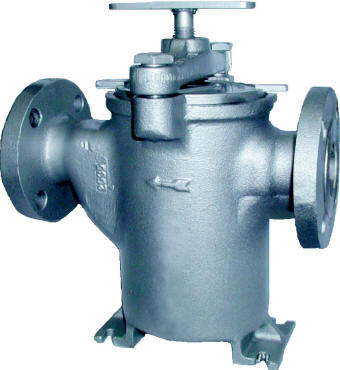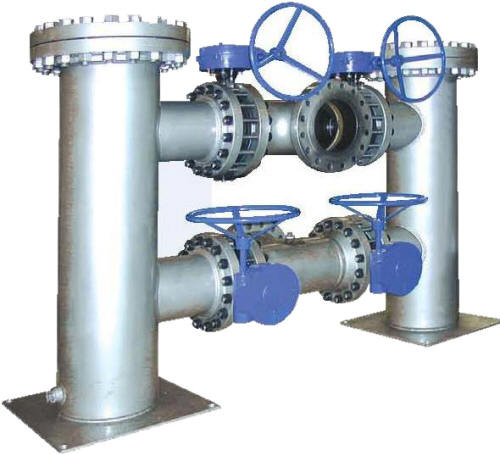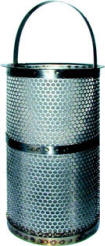Differences between Simplex and Duplex Strainers
Comparison of simplex and duplex basket strainers
Basket strainers are important pieces of equipment used in a wide array of filter applications. It is a closed pressure vessel with a cleanable screen element that filters particulate out of the process liquid to protect valves, pumps, and machines downstream. These strainers are designed to be installed horizontally and to provide quick access to the strainer basket for cleaning. The two most common styles of basket strainers are simplex (single basket) and duplex (dual basket).

Simplex

Simplex Strainer
Simplex Strainers
With the simplex design, baskets can be removed for cleaning only when the process is shut down and thus are used for "batch" applications or processes which can be interrupted for basket cleaning. Usually, shut-down time is minimal due to the quick-opening basket chamber cover closures.
Once the flow has stopped and the strainer
chamber isolated, a vent valve is used to relieve the chamber pressure
and to facilitate quicker draining with the drain valve or plug at the
chamber bottom.
Once the basket has been cleaned of particulate, it is placed
back in the strainer and the application process may continue. Its
common practice to use a spare basket to quickly replace the dirty
basket and then the dirty basket can be cleaned and set aside for the
next cleaning cycle.
Simplex strainers are available
in both cast and custom fabricated designs to match the pipeline
pressure class and material.

Cast Duplex
Strainer

Custom Fabricated Duplex Strainer
Duplex Style Strainers
The duplex
strainer design is for continuous duty applications which cannot
tolerate an interruption in flow for basket cleaning; i.e. the system
flow cannot be interrupted.
A duplex strainer is essentially two simplex
strainers connected with a three-way valve used to divert flow from the
dirty basket chamber to the clean basket chamber.
The style of valve used to divert the flow
differs with cast and custom fabricated designs. Cast designs
require only a lever to divert the flow because there's one three-way
valve being operated. The flow remains continuous because as one
side of the valve closes, the other side opens.
The custom fabricated designs often use four
butterfly valves; sometimes they can be linked to a single operator, however more often they need to be individually opened and
closed, thus the order they are manipulated becomes important. You
begin by opening the inlet valve to the clean chamber, followed by
opening the outlet valve for the clean chamber, then closing the outlet
valve for the dirty chamber and finally closing off the inlet valve to
the dirty chamber.
Once the dirty chamber is isolated, the
access and change-out procedure is the same as it is for a simplex
strainer.
The choice of a cast or custom fabricated design is typically dictated by the design criteria for the application; castings are suggested wherever applicable to reduce cost and lead time.
Sizing Guidelines
There are four general steps to take when
sizing for a strainer:
1) Ensure that the pipeline flow velocity and
clean differential pressure falls within the standard design range of
the strainer.
2) The strainer should be compatible with the
process fluid and satisfy both design pressure and temperature
requirements.
3) Consider the quantity, type, and nature of
debris to be removed.
4) Choose the proper screen perforation/mesh
for your application, if you choose something unnecessarily restrictive
it will increase the clean differential pressure and thus require more
frequent cleaning.

Cv Value
Basket strainers typically have an open area
ratio (OAR) of 6:1 and sometimes as high as 8:1. This is the ratio of
net free area of the screen to pipe area. The area is calculated with a
clean basket and as the basket begins to clog, the ratio will drop. As
material collects on the basket surface, the available amount of open
area is reduced thereby resulting in reduced flow through the strainer
and/or exhibiting a higher differential pressure.
Most strainer elements are perforated and for
finer retentions a second layer of wire mesh cloth is welded to the
basket interior.
The finer the retention, the less open area
the straining element has because there is a certain amount of
structural material required for a sturdy strainer basket design.
Strainer baskets are generally designed to withstand up to 20 PSI
differential pressure, however a properly sized strainer will begin with
<=2 PSI differential pressure and be cleaned once the differential
pressure increases by 5 PSI because at this point nearly all the basket
surface area is covered and the differential pressure will begin to
increase exponentially. The "trick" is to allow sufficient time to
divert flow before the differential pressure increases sufficiently to
damage the strainer basket.
In summary, it is important to know if an
application is batch or continuous before deciding between a simplex and
duplex strainer design.



